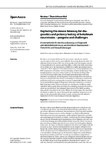Replacing the mouse bioassay for diagnostics and potency testing of botulinum neurotoxins – progress and challenges
Stern, Daniel
von Berg, Laura
Skiba, Martin
Dorner, Martin B.
Dorner, Brigitte G.
Botulinum neurotoxins (BoNTs) are the most potent toxins known and the
causative agents of the rare but potentially life-threatening disease botulism. The
elaborate mode of action of BoNTs at the molecular level, their exquisite specificity
for peripheral motor neurons, and their ability to effectively inhibit neurotransmitter
release led to the development of BoNTs into highly valued pharmaceutical
products. Both diagnostics of botulism and potency testing of pharmaceutical
BoNT preparations still employ the mouse bioassay as “gold standard assay”. This
animal experiment can pose a heavy burden on the animal, including a fatal
outcome of testing. Additionally, several analytical disadvantages have been
described. Consequently, the development of animal replacement methods is a
long pursued goal which has been focused mainly on replacement methods for
pharmaceutical potency testing so far. However, fundamentally different requirements
and challenges apply for diagnostics of botulism and potency testing of
BoNT pharmaceuticals, which necessitates the development of different assays
tailored for each purpose. Here we review the underlying causes for this intricacy
which are rooted in both the biological characteristics of the BoNTs as well as
assay specific requirements. We review different functional assays that have been
developed to replace the mouse bioassay. Despite significant progress in recent
years, further substantial work is needed to pave the way for a fully validated
replacement for the mouse bioassay for botulism diagnostics.
Dateien zu dieser Publikation
Keine Lizenzangabe

